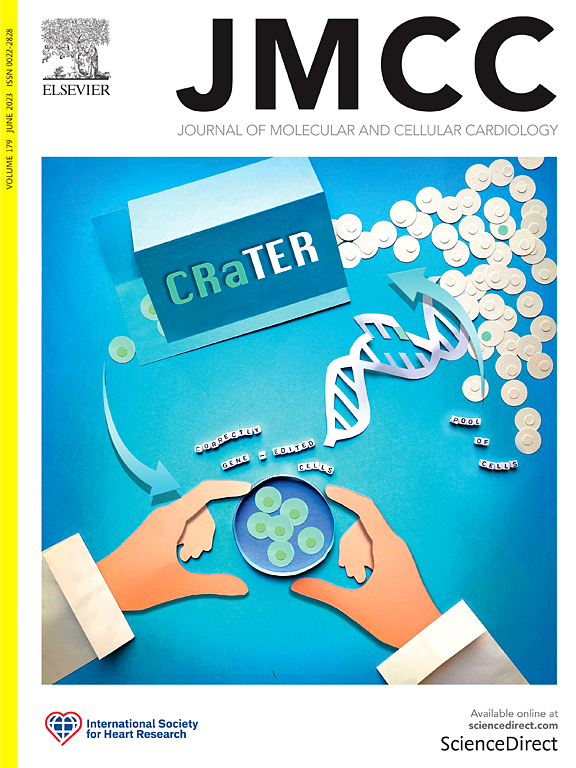Catecholaminergic stress results in signs of heart failure in PP2A-PR72 overexpressor mice
IF 4.7
2区 医学
Q1 CARDIAC & CARDIOVASCULAR SYSTEMS
引用次数: 0
Abstract
Background
It is unclear whether the increase in protein expression of PP2A regulatory subunit PR72 seen in human heart failure represents a primary compensatory mechanism or the final reaction to contractile decompensation. To address this question, we have explored the effects of chronic catecholaminergic stress in a transgenic (TG) mouse model with heart-specific overexpression of PR72 that exhibits hypercontractility at basal conditions.
Methods
Mice were treated with isoprenaline (ISO) or NaCl for 7 days using osmotic minipumps. Hearts or isolated cardiomyocytes from the animals were functionally examined.
Results
We could show (i) that PR72 expression is not only increased after chronic ISO stimulation but also in other different stress and insufficiency models. In TG mice, 7 days of ISO treatment led to (ii) increased hypertrophy, pulmonary edema, more fibrosis, and higher ACTA1 gene expression compared to wild-type (WT) mice. These effects were accompanied by (iii) a decrease in myocellular contractility and prolonged relaxation. Ca2+ transients (iv) showed correspondingly delayed decay kinetics in TG versus WT, while (v) the reduction of L-type calcium peak current by ISO treatment was less pronounced in TG cells. The decrease in RyR2 phosphorylation in TG (vi) supports a deterioration in contractility due to chronic ISO treatment in TG.
Conclusion
Our results indicate that the upregulation of PP2A-PR72 in various stress and heart failure models has a long-term effect, perpetuating the molecular and functional detrimental cardiac changes, if it does not have a triggering effect.

儿茶酚胺能应激导致PP2A-PR72过表达小鼠心力衰竭的迹象。
背景:目前尚不清楚人类心力衰竭中PP2A调节亚基PR72蛋白表达的增加是主要代偿机制还是对收缩代偿的最终反应。为了解决这个问题,我们探索了慢性儿茶酚胺能应激对转基因(TG)小鼠模型的影响,该模型具有心脏特异性PR72过表达,在基础条件下表现出过度收缩。方法:小鼠用渗透微型泵分别给予异丙肾上腺素(ISO)或NaCl治疗7 d。对动物的心脏或分离的心肌细胞进行功能检查。结果:我们可以发现(i)在慢性ISO刺激后,PR72的表达不仅增加,而且在其他不同的应激和不足模型中也增加。在TG小鼠中,与野生型(WT)小鼠相比,7 天的ISO治疗导致(ii)肥大,肺水肿,更多纤维化和更高的ACTA1基因表达。这些影响伴随着(iii)心肌细胞收缩力下降和松弛时间延长。与WT相比,Ca2+瞬态(iv)在TG中显示出相应的延迟衰变动力学,而(v) ISO处理对l型钙峰电流的降低在TG细胞中不太明显。TG中RyR2磷酸化的降低(vi)支持TG慢性ISO治疗导致的收缩性恶化。结论:我们的研究结果表明,在各种应激和心力衰竭模型中,PP2A-PR72的上调具有长期影响,即使没有触发效应,也会使分子和功能上的有害心脏变化永久化。
本文章由计算机程序翻译,如有差异,请以英文原文为准。
求助全文
约1分钟内获得全文
求助全文
来源期刊
CiteScore
10.70
自引率
0.00%
发文量
171
审稿时长
42 days
期刊介绍:
The Journal of Molecular and Cellular Cardiology publishes work advancing knowledge of the mechanisms responsible for both normal and diseased cardiovascular function. To this end papers are published in all relevant areas. These include (but are not limited to): structural biology; genetics; proteomics; morphology; stem cells; molecular biology; metabolism; biophysics; bioengineering; computational modeling and systems analysis; electrophysiology; pharmacology and physiology. Papers are encouraged with both basic and translational approaches. The journal is directed not only to basic scientists but also to clinical cardiologists who wish to follow the rapidly advancing frontiers of basic knowledge of the heart and circulation.

 求助内容:
求助内容: 应助结果提醒方式:
应助结果提醒方式:


